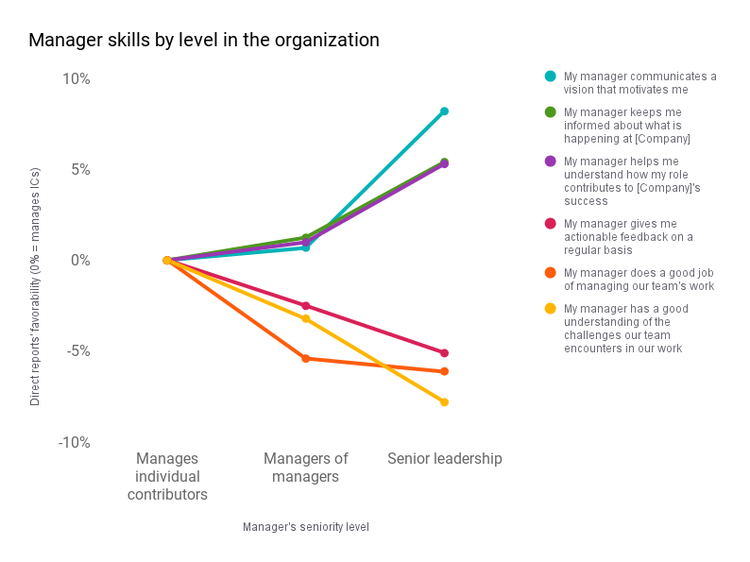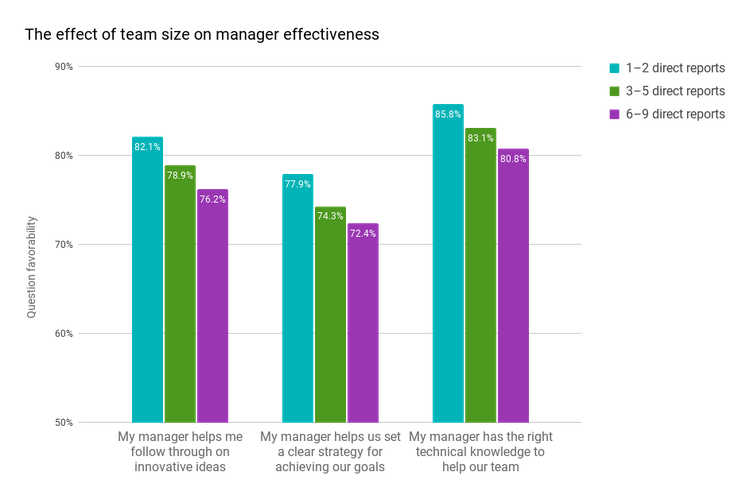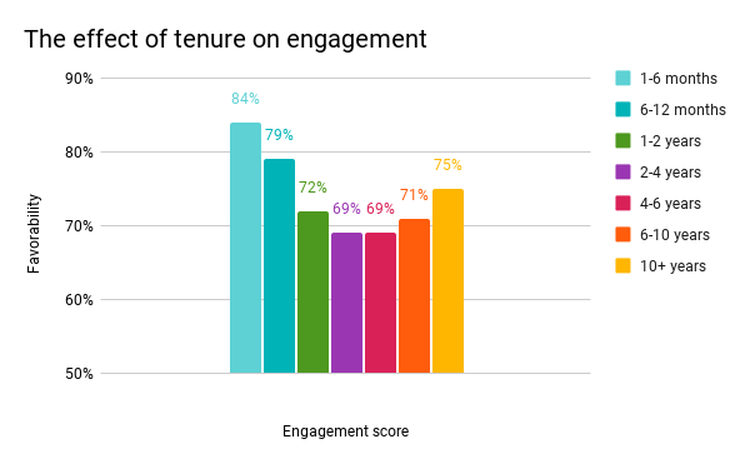
Written by

Director of People Science Research, Culture Amp
In our first installment of this manager-focused blog series, we shared what we found from analyzing almost 150,000 managers with ratings from over 2.5 million employees across 2,700 different companies. We covered the basics of where managers were excelling and falling short and how that’s changed since COVID-19. These findings looked at the aggregate insights (i.e., averaging results across all managers), which - while interesting - can obscure meaningful differences. In this article, we’ll go one level deeper by looking at different groups to see what impacts managerial effectiveness.
On the manager side, it’s conceivable that what they have on their plate and the time they have for each direct report would impact their effectiveness. On the direct report side, it’s possible that managers treat direct reports differently based on their experience level in the company.
In this blog, we’ll answer
- How do manager skills change as they ascend the hierarchy?
- Does the number of direct reports a manager has really matter?
- How does the direct report’s tenure affect their managerial experience?
Knowing the answers to these questions may give managers the awareness they need to course-correct, and people teams the insights they need to customize management programs that truly fit and fulfill manager needs.
Our methodology
To explore the factors that impact managerial effectiveness, we again turned to results from Culture Amp’s Manager Effectiveness survey, which covers 10 factors that encompass key manager behaviors.
Direct reports answering the survey assess their manager’s effectiveness with a 5-point Likert scale that ranges from “strongly disagree” to “strongly agree.” If a direct report agrees or strongly agrees with a given statement (e.g., “My manager makes me feel valued”), they are considered favorable. This number is then averaged across all of a given manager’s direct reports.
We used this approach to answer the three questions posed above. Below are our key findings.
1. As managers are promoted to senior leaders, there’s a distinct shift in skills
There’s a plethora of advice available to new managers on everything from what they need to know, the skills they need to develop, to how they can ramp up. But few advice-givers have considered that as a manager gets promoted to higher and higher levels, the skills managers need to be seen as “effective” change, too.
We analyzed a subsection of managers (95,000) for whom we were able to identify the number of management levels below them. We found that some skills show exponential improvement as a manager goes up the hierarchy, while others decline.
In particular, senior leaders (those with 4+ levels of management below them) become more adept at providing vision. They also excel at giving context, like keeping their direct reports informed of what’s happening and aware of how their role contributes to the big picture. But there’s a marked decrease in day-to-day management skills like giving feedback, managing workloads, and understanding the everyday challenges their direct reports face.

These changes illustrate the transformation from manager (prioritizing and executing) to leader (strategizing and motivating).
It’s important to note that while senior leaders were worse at some skills, their overall effectiveness (assessed with the question “I would recommend this person as a manager”) was rated similarly across levels. This indicates that the “food, water, and shelter” aspects of management that are critical for junior-level direct reports (e.g., managing the team’s work, understanding challenges, and removing barriers), are not the same skills that are critical for leading senior managers and their direct reports.
💡Insight: People teams should craft manager and leadership training programs based on the level of the manager. Individual contributors crave the basics of management - managers that can understand their challenges, help them prioritize their work, and provide feedback. On the other hand, senior managers seek additional context from their own manager that they can share with their direct reports.
2. The time a manager can devote to each direct report matters
When it comes to the number of direct reports a manager can handle, there are many variables that come into play, like the complexity of the role and the experience of the manager. But a general guideline is 7 ± 2 is the max number of direct reports a manager can handle and still be effective. For Culture Amp customers, the average appears to be 5, but other large datasets have found averages as high as 9-11 direct reports.
When comparing managers by their number of direct reports, we found that managers with 1-2 direct reports were always rated higher than those with more than 3 direct reports. While the differences were relatively small, the largest differences (with over 5% difference between 1-2 direct reports and 6-9 direct reports ) were related to getting the work done.
Specifically, managers with fewer direct reports scored higher on helping their direct report follow through on innovative ideas, setting a clear strategy for goal achievement, and having the technical knowledge to help their team when they get stuck.

💡Insight: Having more employees report to the same manager can be more efficient and improve alignment across the organization, but it comes with a cost. To determine if direct reports may benefit from having more of their manager’s time, look at each team and consider how much strategy and guidance is necessary for success.
3. The tenure of the direct report impacts how managers manage
Next, we investigated if there are differences in how managers are rated by direct reports of different tenures. Direct reports who have been with the company for less than a year are more positive than their longer-tenured peers. In fact, new employees rated their manager better on every skill assessed, with some differences being as large as 13% compared to employees that have been with the organization for 10+ years.

In engagement surveys, we see a similar honeymoon period, with employees in their first year scoring the most favorably. But there’s one crucial difference for engagement: after 6 years we see engagement go back up, forming a U-shape. For manager effectiveness, we see a linear decrease. This suggests that in addition to a general decrease in favorability as an employee becomes more tenured, there are also differences in how managers manage longer-tenured employees.

💡 Insight: It’s easy to assume your longer-tenured employees are able to self-manage and don’t need help. Remind your managers that tenured employees want the same things new hires want - to be recognized, to receive actionable feedback, and to have a career in front of them.
Customized learning and development for managers is the key
Overall, we found that what managers have on their plates matters. We can see that as teams grow and managers go from managing their people to leading their people, managers develop new skills but become less effective at helping their direct reports get work done.
But we can’t forget the other side of the coin - who the direct report is can affect the way a manager approaches them. As an employee’s tenure increases, the way they rate their manager generally decreases. Each of these findings suggests people teams should be personalizing manager development programs to take into account both what the manager and the direct report needs.
Check out the final blog in this series, where we dive into gender dynamics in management.

Upskill your managers to support employee growth
Develop by Culture Amp makes employee development easy and scalable for everyone.




